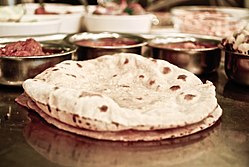 Chapatis served with various side dishes | |
| Alternative names | Roti, roshi, safati, shabaati, phulka, lavash |
|---|---|
| Type | Bread |
| Place of origin | Indian subcontinent |
| Region or state | Indian subcontinent, Central Asia, Southeast Asia, East Africa, United Kingdom, Arabian Peninsula, Caribbean, Armenia |
| Main ingredients | Wheat flour, water |
Chapati (alternatively spelled chapathi; pronounced as IAST: capātī, capāṭī, cāpāṭi), also known as roti, rooti, rotee, rotli, rotta, safati, shabaati, phulka, chapo (in East Africa), sada roti (in the Caribbean), poli (in Marathi), and roshi (in the Maldives),[1] is an unleavened flatbread originating from the Indian subcontinent and is a staple in India, Nepal, Bangladesh, Pakistan, Kyrgyzstan, Sri Lanka, the Arabian Peninsula, East Africa, and the Caribbean.[2] Chapatis are made of whole-wheat flour known as atta, mixed into dough with water, oil (optional), and salt (optional) in a mixing utensil called a parat, and are cooked on a tava (flat skillet).[3][4]
It is a common staple in the Indian subcontinent as well as amongst expatriates from the Indian subcontinent throughout the world. Chapatis were also introduced to other parts of the world by immigrants from the Indian subcontinent, particularly by Indian merchants to Central Asia, Southeast Asia, East Africa, and the Caribbean.[5]
- ^ Oliver, Jamie. "Roshi ( maldivian roti)". Jamie Oliver. Archived from the original on 19 February 2017. Retrieved 18 February 2017. (recipe)
- ^ Cite error: The named reference
originwas invoked but never defined (see the help page). - ^ Nandita Godbole, 2016, Roti: Easy Indian Breads & Sides Archived 8 April 2023 at the Wayback Machine.
- ^ Chitra Agrawal, 2017, Vibrant India: Fresh Vegetarian Recipes from Bangalore to Brooklyn Archived 8 April 2023 at the Wayback Machine, page 35.
- ^ Kraig, Bruce; Sen, Colleen Taylor (2013). Street Food Around the World: An Encyclopedia of Food and Culture. ABC-CLIO. p. 124. ISBN 978-1-59884-954-7.